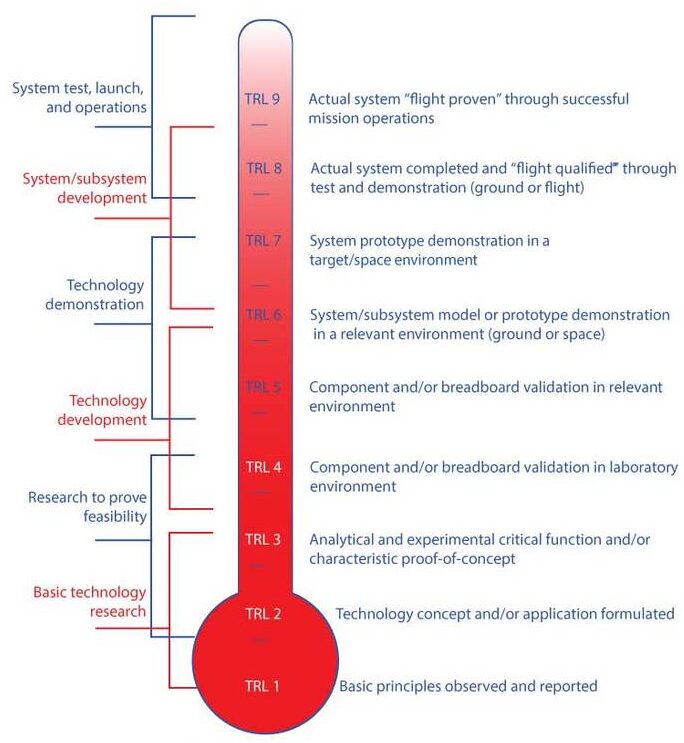
Focused Topics
Guidance on common topics relevant to developing technology for NASA.
Science Traceability Matrix (STM)
The Science Traceability Matrix (STM) is a tool used by NASA science missions that provide a logical flow from science goals and objectives to mission and instrument requirements and data products. It serves as a concise summary of what science will be achieved, combined with how it will be achieved. It is also a required element of NASA science mission proposals.
Science Goals are general statements about the science themes that will be addressed and must be strongly related to NASA science goals as described in the NASA Strategic Plan or other relevant documents.
Science objectives are specific science statement or questions that can be addressed or answered completely. They should be (or be associated with) testable hypothesis-driven predictions.
Measurement requirements provide a bridge between the science objectives and the instrument requirements. The measurement requirements describe what needs to be quantified (and how well) to reach scientific closure on the science objective(s). Science objectives require that a physical parameter be measured or constrained, but not many physical parameters can be measured directly. For example, a science objective related to the formation of asteroids may require that the amount of nickel present in the asteroid be determined. A mission may remotely determine the amount of nickel by measuring gamma-rays (the observable) emitted by the radioactive nickel present on the surface and use that to calculate the total amount of nickel present.

Instrument requirements and instrument performance describe how well the physical sensors or instruments must measure the observable while the performance describes the capabilities of the selected sensors. Performance should always be greater than the required capability. The difference between these two parameters is referred to as margin and is related to the robustness of the mission.
Mission requirements are like instrument requirements but are associated with the higher-level mission specifications, such as how well the spacecraft must point the instruments or how long the mission must last to make all the required measurements.
Additional reading and references
- Introduction to the Science Traceability Matrix, 2021 PI Launchpad
- Introduction to the Science Traceability Matrix, 2019 PI Launchpad
- J. R. Weiss, W. D. Smythe and Wenwen Lu, “Science traceability,” 2005 IEEE Aerospace Conference, Big Sky, MT, USA, 2005, pp. 292-299, doi: 10.1109/AERO.2005.1559323 (publisher link, pdf link)
- NASA Psyche Mission STM
Technology Readiness Level (TRL)
Technology Readiness Levels (TRL) are a type of measurement system used to assess the maturity level of a particular technology typically for us in space.
Generally, technologies assessed from TRLs 1 to 5 require development while TRL 6 and above are considered mature. NASA missions typically require that all technologies be TRL 6 or above, unless stated otherwise, when flown. For missions such as Small Explorers, development plans for technologies below TRL 6 are generally acceptable if the technology is matured well before it is to be launched. Regardless of maturity, the TRL of all technologies in NASA missions must be justified by providing their heritage in writing.
Additional reading and references
- M. A. Frerking and P. M. Beauchamp, “JPL technology readiness assessment guideline,” 2016 IEEE Aerospace Conference, Big Sky, MT, USA, 2016, pp. 1-10, doi: 10.1109/AERO.2016.7500924 (publisher link, pdf link)
- NASA Technology Readiness Assessment Best Practices Guide (link)
- NASA Systems Engineering Handbook Appendix G: Technology Assessment/Insertion
- NASA Technology Readiness Criteria Chart

Radiation Testing
Instruments exposed to space are exposed to a harsh radiation environment which may be comprised of charged particles trapped by Earth’s magnetosphere, galactic cosmic rays, and solar energetic particles. The intensity and composition of the radiation depend on many factors including the amount of spacecraft shielding, the orbit altitude, and whether the orbit traverses particularly radiation-intense regions of the Earth’s magnetosphere such as the Van Allen belts, polar regions, or South Atlantic Anomaly (SAA). They also depend on transient factors like solar activity. Exposure to such an environment can negatively impact the operation of electronics therefore it is crucial to assess its radiation tolerance before deploying it as part of a space-based instrument.
Radiation can impact the operation of electronics via multiple mechanisms. The total ionizing dose (TID) — the cumulative ionising radiation to which a part is exposed over its lifetime — can degrade components and hence alter, reduce, or even terminate their operation. In addition, single event latchups (SELs) can be caused by intense local ionization due to the passage of charged ions through the part. This can activate parasitic thyristors which by their nature will remain activated until the power is cycled. Radiation testing generally requires testing both potential effects and may be the most difficult part of TRL maturation. Radiation testing is most important for custom or complex electronics components such as ASICs or FPGAs.
Radiation testing of a particular part may have already been performed by others. Parts databases are available though due to the large number of electronics parts available in our modern age, unless the part is extremely common it may be difficult to find any public data.
Additional reading and references
- D.F. Ryan et al 2018 JINST 13 P02030, “Tolerance of the High Energy X-ray Imaging Technology ASIC to potentially destructive radiation processes in Earth-orbit-equivalent environments” DOI 10.1088/1748-0221/13/02/P02030 (publisher link), a good reference that discusses radiation testing and radiation dose in different orbits.
- R-GENTIC: Tool for evaluating radiation risk in space
- GSFC Radiation Database
- ESA Radiation Database
- It is not uncommon for radiation groups to publish compendiums of test data to summarizes recent test campaigns. Radiation Effects is largely consolidated under the banner of IEEE’s Transactions on Nuclear Sciences (TNS) and most of the time test data will be published in conjunction with the two predominant conferences NSREC and RADECS. Here are a couple of examples.


